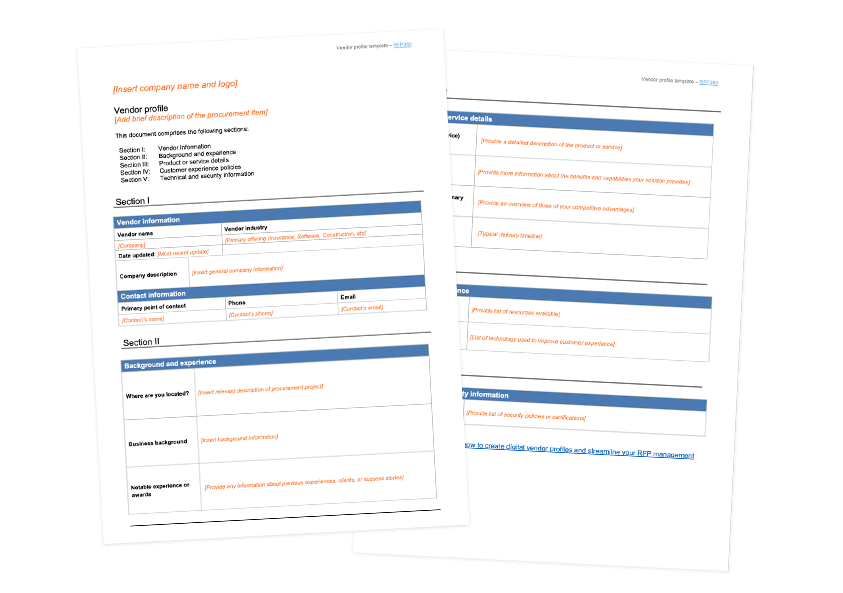Vendor onboarding is an important part of strategic sourcing and supplier relationship management. Indeed, the vendor onboarding process is like an official introduction at the very beginning of a new relationship. You’re starting to get to know each other, building an understanding and setting the groundwork to ensure a long-term, mutually-beneficial partnership. Accordingly, establishing a consistent, clear and organized vendor onboarding process delivers a positive experience for both parties.
In this blog, we’ll explore vendor onboarding. To begin, we’ll share key background information and definitions. Next, we’ll walk through the steps of the vendor onboarding process. Finally, we’ll share a helpful vendor onboarding checklist for you to use.
Vendor onboarding basics
Before exploring the vendor onboarding process, it’s important to understand the role it plays in procurement and supplier relationships.
What is vendor onboarding?
Vendor onboarding, also known as supplier onboarding or vendor intake, is the process of gathering and providing information to establish a relationship with a new vendor.
During onboarding, new vendors answer standard questions and provide documentation as needed. Then, they learn more about the company and receive guidance on the organization’s processes, practices, compliance and expectations. The goal is to ensure that both parties have the right information and documentation to work together productively, minimize risk and maximize the value of the partnership.
Prior to purchasing goods or services enable you to purchase goods and services from the company. Gathering data and setting expectations
The two roads to onboarding
As with many terms, vendor onboarding may mean different things to different businesses. There are two primary approaches to the vendor onboarding process — one initiated when an organization awards a contract and the other initiated by a vendor. You may use one or a combination of both, depending on your needs.
Onboarding after an RFP
When an organization issues an RFP (request for proposal), they gather decision-related information from prospective vendors. Then, the project stakeholders score the RFP and select a winner to award the contract to. In this scenario, vendor onboarding would commence once negotiations and contracting with the new supplier are complete.
Organizations that use the process this way only exchange onboarding information with current, active vendors. Because the RFP has already laid the groundwork and there is a specific goal in mind for the engagement, the collaboration is timely, customized and highly-focused for both parties. The advantage is that you only invest time in onboarding vendors as needed.
Vendor-prompted intake
The second approach to vendor onboarding is frequently used by large- and enterprise-sized organizations. In this model, the vendor onboarding process is initiated proactively by a prospective supplier. While the business may not have an immediate need, the vendor provides their info in the hope that they can be considered for future contracts or needs. Often, organizations that use this approach direct inquiring parties to a vendor profile or form available on their website.
The advantage of this strategy is the standardization of data and creation of a pre-qualified vendor pool. When used this way, the vendor intake form is essentially an evergreen request for information (RFI). Then, when the business needs to issue an RFP, they simply refer to their existing list of vetted vendors.
Check out this blog to learn more about vendor profiles, download a template and explore real-life examples from organizations that use this approach.

Benefits of formalizing a vendor onboarding process
Successful vendor onboarding plays a crucial role in the overall supplier experience. If it’s not part of your supplier relationship management approach, it probably should be. Establishing a smooth process for vendor onboarding delivers multiple benefits.
- Introduces key players, empowering collaboration
- Ensures consistent data collection
- Creates a clear path for stakeholder engagement
- Improves implementation and project management
- Mitigates risk, verifies security qualifications and compliance
- Boosts overall vendor engagement
- Reduces time to value while increasing long-term ROI
3 steps to the vendor onboarding process
As with all processes, efficiency is key in vendor onboarding. Accordingly, the extent of your onboarding process will vary depending on your level of engagement.
For example, you need more information about the company that provides your employee benefits and less information from the vendor who delivers office pens. Remember, it should always strike a balance between time invested and benefits received.
While these three steps should be involved in every vendor onboarding engagement, the time required will vary. Be sure your vendor onboarding process is flexible enough to work with the full spectrum of vendors.
1. Exchange information and verify documents
The first step of the process is all the companies getting to know each other. You’re going to exchange a lot of information. Some of it will be essential reading, while some you can just scan over and keep on record.
Information you should provide to vendors
-
- Company mission, vision and values
- Vendor code of conduct
- Company overview
- Project background, challenges and goals
- Contact information for billing
- Avenues for feedback
If you’re onboarding after an RFP, you likely have a head start when it comes to gathering basic company information. However, this is a good time to gather certifications, policies or compliance documents that were alluded to (but not produced) during the vendor selection process. Trust but verify.
Sample vendor documentation you may need to gather
-
- Company ownership documentation
- Tax information, forms and identification numbers
- Non disclosure agreements (NDA)
- Insurance policies
- Supplier diversity certifications
- Sustainable sourcing reports
- Subcontractors, outsourced functions and fourth parties
- Financial records/credit history
- Security certifications
- Regulatory compliance information
- Required business licensing
- ACH forms
2. Align your people, processes and approach
Collaboration will play a big part in your overall success with a vendor. So, schedule short, informal introductory meetings between key players who will work closely together.
Consider connecting departmental stakeholders to their counterparts in the vendor’s organization. For example, connect your accounts payable representative to the vendor’s accounts receivable contact. Again, remember to scale this step to match the importance and value of the engagement. Even if key players don’t need to have a meet and greet on the phone, make introductions via email to ensure that there’s a clear path for communication.
During these meetings and discussions, ask questions, learn about each other and plan your approach.
Key questions for process planning
- Who are the primary internal stakeholders and vendor contacts for your account?
- What roles do they play, and who will they interact with?
- Who will have access to company data?
- How will the vendor engage users?
- Where should users go if they have questions?
- How and when will deliverables be received and reported?
- Who is responsible for account management, troubleshooting, support and so on?
- How should the vendor share updates and ideas with your team?
- If a key team member leaves, who will be responsible for filling that role and ensuring you maintain momentum?
If possible, collaborate to establish and map key processes. Not only does this enable your team to better capture the value of the partnership as time goes on, it also enables you the opportunity to review and optimize.
3. Set expectations and next steps
The final step in the vendor onboarding process is deciding how success will be measured and what comes next. Ideally, you already have an established supplier relationship management process that includes a schedule for vendor performance evaluation.
Share a sample evaluation form, establish benchmarks for your current state and agree on key performance indicators (KPIs). In addition to quarterly or twice-yearly performance reviews, let vendors know when they should expect to receive vendor risk assessments to ensure ongoing compliance.
Now, what’s next? Ask your new vendor what else they might need from you to ensure a smooth engagement. Be prepared to provide historical records, data and access to IT personnel. Remember, once you’re done with this process, you should be off and running. This is your final chance to verify you both have what you need to be successful.
Quick tips for effective onboarding
Assign an owner: While vendor onboarding includes a lot of introductions, it’s best to pick a single point of contact to own the process. This person should feel comfortable and confident working through the vendor onboarding checklist, guiding conversations, problem solving and setting the tone for the engagement.
Create connections: Consider this an opportunity to network rather than a task to check off your list. If you can approach each conversation with positivity, genuine interest and a spirit of curiosity, the process can be incredibly rewarding.
Tap into their expertise: You select vendors (at least in part) based on their qualifications and expertise, so don’t leave that value on the table. Throughout onboarding, encourage vendors to make suggestions and ask questions. After all, the more engaged they are during onboarding, the better off you’ll be.
Automate early and often: Gathering data is tedious and time consuming. Unfortunately, that’s the bulk of vendor onboarding. Therefore, when you’re building your supplier onboarding process, keep an eye out for opportunities to automate. Leverage procurement technology you may already have. For example, you may already own a survey tool, vendor management system, contract management system or an RFP tool for RFP automation that can easily be applied to vendor onboarding.
Regularly review and optimize: We give this advice anytime we discuss processes. The time, energy and organization you put into a process will certainly deliver benefits, but you can maximize the value with regular reviews. Often, this step gets overlooked because everyone is busy and you’re procurement team is working lean. Avoid overlooking it by scheduling time to optimize at least once a year.
Vendor onboarding checklist examples
Even for veteran procurement managers, remembering all the steps to onboarding can be a challenge. Consequently, many create a vendor onboarding checklist to help them navigate the process. To help you get started, you’ll find examples of a vendor onboarding checklist below. As with any template or example, remember to carefully review and customize before deploying.
Lowes – Vendor onboarding checklist: This vendor onboarding checklist from home improvement retailer, Lowes, gives an overview of how a vendor enters their system and what documentation is required. Additionally, there are links throughout to additional information, systems and guides.
Walmart – Supplier onboarding checklist: Formatted exactly like an RFX, this vendor readiness checklist is a great way to gather information in an organized and standardized way. It also includes links for more information and could easily be digitally issued using an RFP management system.
EFTSure – Supplier onboarding checklist: Contained on one page and visually appealing, this clickable PDF breaks the vendor onboarding process into steps. While short, it covers all the information required to ensure a smooth vendor onboarding experience.
Ultimately, your vendor onboarding process can either be the launching point for a valuable partnership or the rocky start to a unproductive pairing. Hopefully, this guide provides you the tools and information you need to ensure success and maximize vendor value for years to come.



